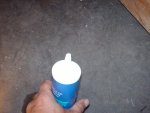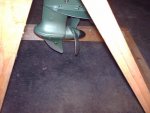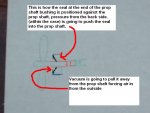Mr.Stuart
Senior Chief Petty Officer
- Joined
- Jul 18, 2007
- Messages
- 701
Re: 1955 Johnson 5.5 CD-12, will it run again?
About the Prop,
the 3 pictures below are the sequence of how I put the prop back on.
I got a new cotter pin, (I don't like using the old cotter pins over again) you can pick those up at any hardware store. I installed it first (first picture), then I installed the sheer pin, (second picture) then the rubber cone, (thrird picture)
we're going to get into the subject of a tool box to carry on board when your out on the water running these vintage outboards, I'll go into the full deatails of what I think would be a good idea to have into that tool box at a later time, but this prop brings up a good thought, at least for me.
the sheer pin is held in place by that rubber cone, which means, if you lose that cone, the sheer pin is going with it, and that will leave you stranded out on the water.
I've already started collecting parts to include in my tool box that I will be carrying on board, and part of what I want on hand will be an extra sheer pin or two, but in the case of this particular motor, that rubber cone kind of bothers me, it's as old as the motor, 54 years old, and if it comes off or breaks or something, my fun on the water is done, and I'll be finding myself paddling back to the dock, so I believe it would also be a good idea to carry an extra rubber prop cone in my tool box as well.
luckily, those parts are still avalable, the prop cone is BRP number 0303365, and the sheer pin number is 0302333
next up is the lower unit oil, but I'm going to do a little more internet research before I post my findings, so far I've come across some interesting data, I'll get it all together and then post it, you can decide what's fact, what's myth, what to use, and what not to use.
About the Prop,
the 3 pictures below are the sequence of how I put the prop back on.
I got a new cotter pin, (I don't like using the old cotter pins over again) you can pick those up at any hardware store. I installed it first (first picture), then I installed the sheer pin, (second picture) then the rubber cone, (thrird picture)
we're going to get into the subject of a tool box to carry on board when your out on the water running these vintage outboards, I'll go into the full deatails of what I think would be a good idea to have into that tool box at a later time, but this prop brings up a good thought, at least for me.
the sheer pin is held in place by that rubber cone, which means, if you lose that cone, the sheer pin is going with it, and that will leave you stranded out on the water.
I've already started collecting parts to include in my tool box that I will be carrying on board, and part of what I want on hand will be an extra sheer pin or two, but in the case of this particular motor, that rubber cone kind of bothers me, it's as old as the motor, 54 years old, and if it comes off or breaks or something, my fun on the water is done, and I'll be finding myself paddling back to the dock, so I believe it would also be a good idea to carry an extra rubber prop cone in my tool box as well.
luckily, those parts are still avalable, the prop cone is BRP number 0303365, and the sheer pin number is 0302333
next up is the lower unit oil, but I'm going to do a little more internet research before I post my findings, so far I've come across some interesting data, I'll get it all together and then post it, you can decide what's fact, what's myth, what to use, and what not to use.



































